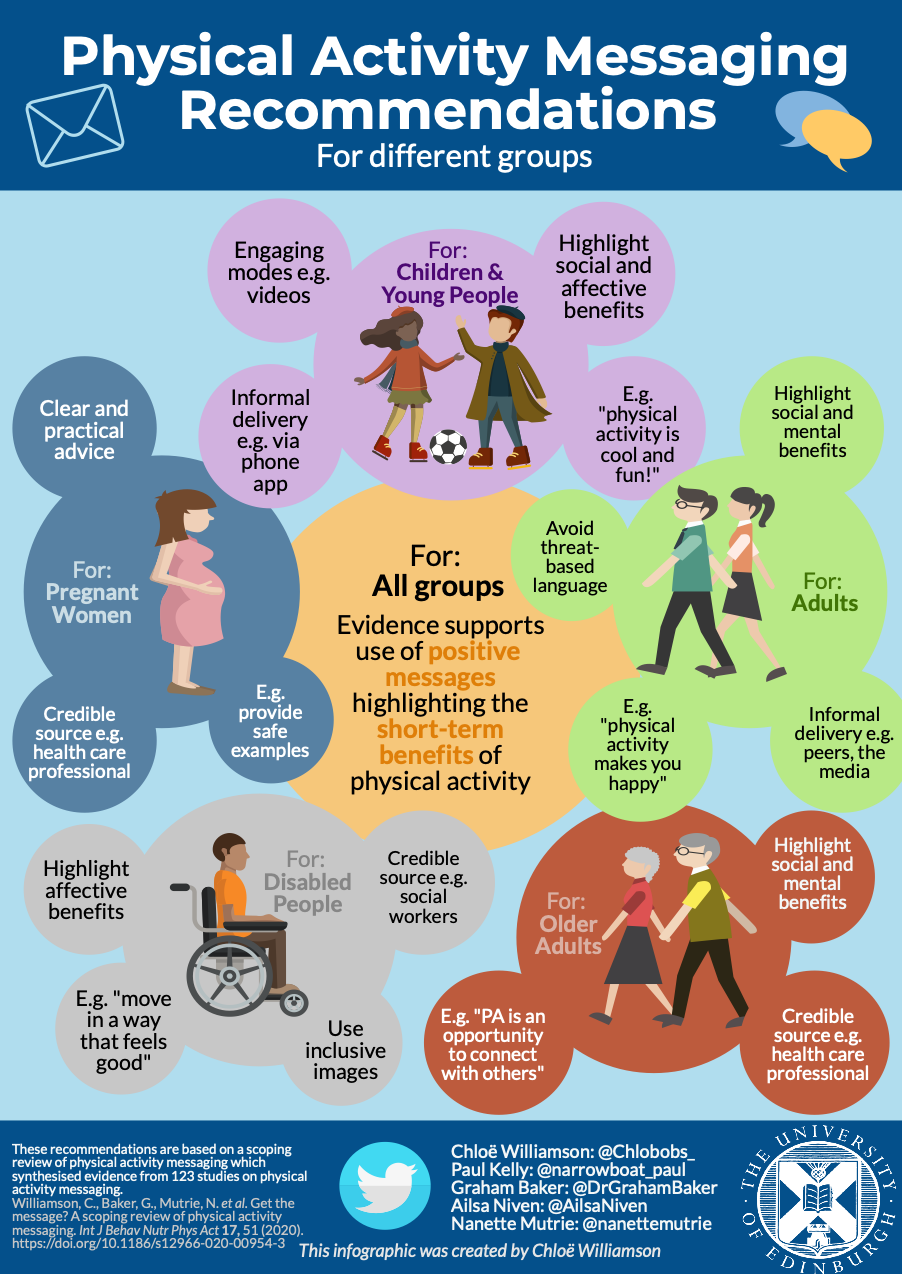Messages to movement
The role of messaging in improving population physical activity levels

As researchers, healthcare professionals and policymakers in the field of public health, we know that physical activity is important for health. We know that it is important for the general public to move more and sit less. We spend time and resources researching the relationships between physical activity and various health outcomes, and we create environmental, structural and political change to encourage the public to be more active. But how to we convince the public to engage with these opportunities for physical activity? How do we encourage them to ditch the car and use the cycle lanes we have put in place? How do we convince them to trade some of their TV viewing time for walking outdoors?
Alongside political and environmental approaches to improving physical activity levels, an ecological perspective would support the need to target individual factors such as attitudes, perceptions and awareness, as well as social norms regarding physical activity. If Coca-Cola had their products available on the shelves but didn’t advertise them, would anybody buy them? One way to encourage the public to engage with physical activity opportunities is through physical activity messaging. But how do we best message physical activity to the public?
What is important to us may not be important to the public
Understanding the links between physical inactivity and physical health is a priority in our field and has been for a long time. These links are now very well established; higher levels of physical activity are associated with reduced mortality rates and reduced risk of many diseases [1, 2]. Whilst these links are important for us, do we too quickly assume that these same links are what is important to the public? Perhaps, as the majority of physical activity messages to the public to date have focused on the physical health benefits.
We may have a lot to learn from the social marketing field here. We are essentially promoting a product (physical activity) to the public in exchange for a cost (time, money, energy and other resources). How can we make our physical activity “product” appealing? It can be argued that promoting reduced risk of non-communicable disease later in life may not be the solution. Would Coca-Cola sell if the perceived benefits did not occur until 20 years later? They promote feeling good here and now; people drink Coca-Cola because they enjoy it. The public may therefore be more interested in what they can gain from being physically active in the (immediate) short term. With growing interest and subsequently research into the links between physical activity and mental health [3], it may be time to try a new approach.
A new focus for physical activity messaging to the public
Our recent scoping review of physical activity messaging [4] reviewed and summarised 123 studies and provided recommendations for physical activity messaging to different population subgroups. A key finding which was consistent across all populations groups was that physical activity messages should highlight the benefits of physical activity (rather than the consequences of inactivity), particularly the short-term mental and social health benefits. For older adults, this may mean highlighting physical activity as an opportunity to spend time with loved ones. For children, they may mean promoting physical activity as fun and cool. For disabled people, this may mean promoting physical activity as a way of feeling good. We are currently in the process of gaining expert feedback and consensus on these principals to develop a user-friendly framework [5] for creating (and evaluating) physical activity messages.
With this new evidence to support the communication of acute benefits of physical activity coupled with the growing evidence base for the mental health benefits of physical activity [2, 3, 6, 7] it seems we are far better placed to promote happiness to the public from our physical activity ‘product’ than Coca-Cola are.
Authors and Affiliations:
Chloë Williamson
Physical Activity for Health Research Centre (PAHRC), University of Edinburgh
Email: chloe.williamson@ed.ac.uk
Twitter: @Chlobobs_
Paul Kelly
Physical Activity for Health Research Centre (PAHRC), University of Edinburgh
Email: p.kelly@ed.ac.uk
Twitter: @narrowboat_paul
Graham Baker
Physical Activity for Health Research Centre (PAHRC), University of Edinburgh
Email: graham.baker@ed.ac.uk
Twitter: @DrGrahamBaker
References:
- Strain, T., et al., Wearable-device-measured physical activity and future health risk. Nature medicine, 2020. 26(9): p. 1385-1391.
- Lee, I.M., et al., Effect of physical inactivity on major non- communicable diseases worldwide: an analysis of burden of disease and life expectancy. Lancet, 2012. 380(9838): p. 219-229.
- Kelly, P., et al., Walking on sunshine: scoping review of the evidence for walking and mental health, in Br. J. Sports Med. 2018. p. 800-+.
- Williamson, C., et al., Get the message? A scoping review of physical activity messaging. International Journal of Behavioral Nutrition and Physical Activity, 2020. 17(51).
- Williamson, C., et al., A conceptual framework for physical activity messaging. 2019, University of Edinburgh.
- Lubans, D., et al., Physical Activity for Cognitive and Mental Health in Youth: A Systematic Review of Mechanisms, in Pediatrics. 2016.
- Lathia, N., et al., Happier People Live More Active Lives: Using Smartphones to Link Happiness and Physical Activity. PloS one, 2017. 12(1): p. e0160589.